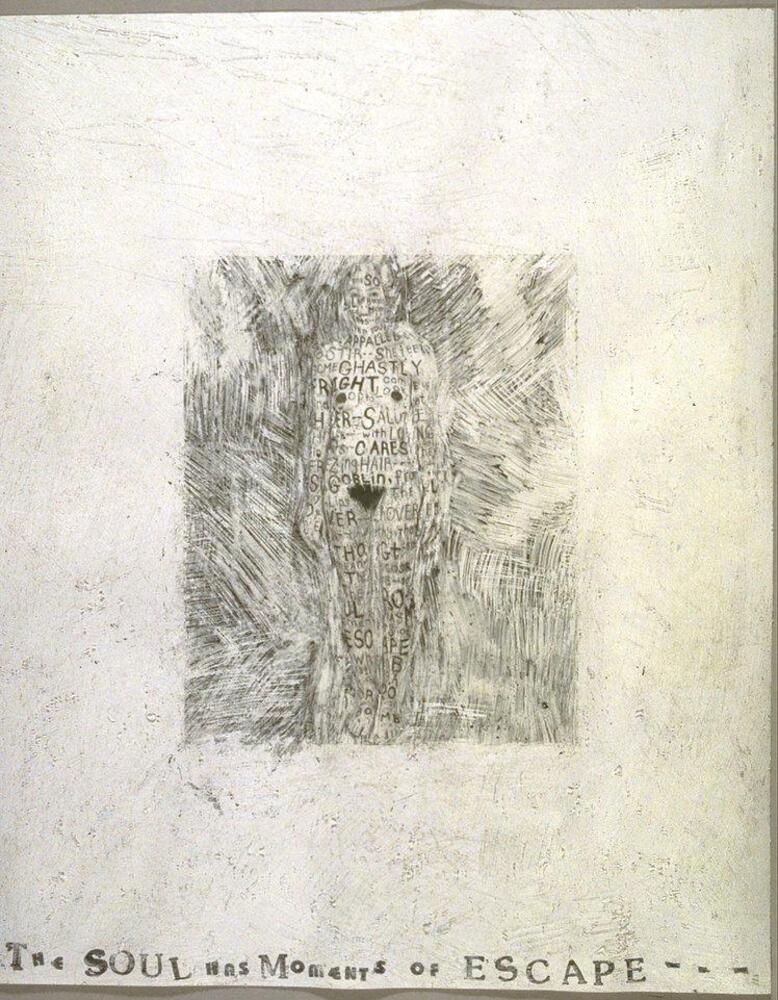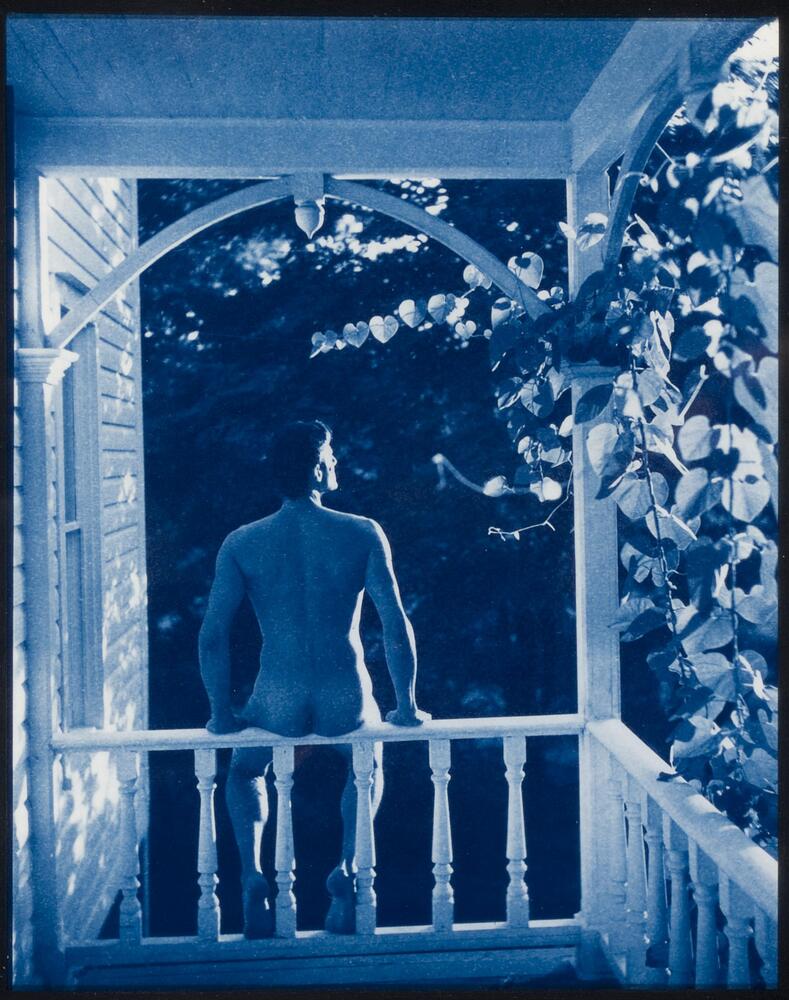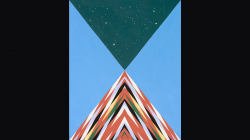
How To Think: Images, Process, and Creativity/Cyanotype
RCHUMS 202
Raymond Wetzel (Residential College)
On view: FALL 2022

Joan Snyder, Art and the Nature of Grief, 1992, monoprint on paper, Museum purchase made possible by the Jean Paul Slusser Memorial Fund
Art can be both a visual manifestation of how we think and a demonstration of different ways to think about and engage with the world.
“How To Think: Images, Process and Creativity” is a class that asks students to consider how various art processes and techniques stimulate and affect the expression of ideas. Students make mixed media collages featuring cyanotype, an early form of photography that produces images in distinctive hues of blue. By recombining and rearranging existing images, their collages foster new and unexpected connections and perspectives.
The photographs selected for this class, seen below, represent some of the wide range of ways that artists have creatively explored the medium of photography. Techniques include photomontage and collage (the combining of photographs into one image), photograms (where images are produced without a camera by laying objects on photographic paper), and a variety of uses of the camera to capture everyday life and nature.
Works included in this collection

2016/2.110
Title
Jap
Artist(s)
Robert Rauschenberg
Artist Nationality
American (North American)
Object Creation Date
1999
Medium & Support
photolithograph on paper
Dimensions
19 ¾ in x 26 in (50.17 cm x 66.04 cm);22 ⅞ in x 28 ¾ in (58.1 cm x 73.02 cm)
Credit Line
Bequest of Gertrude Kasle
Physical Description
A black and white image of a man seated next to American flag in the shape of a water stain.
Primary Object Classification
Collection Area
Modern and Contemporary
Rights
If you are interested in using an image for a publication, please visit http://umma.umich.edu/request-image for more information and to fill out the online Image Rights and Reproductions Request Form.
Jap
photolithograph on paper
19 ¾ in x 26 in (50.17 cm x 66.04 cm);22 ⅞ in x 28 ¾ in (58.1 cm x 73.02 cm)
Bequest of Gertrude Kasle

2018/2.156.1
Title
Procession, Michigan
Artist(s)
Howard Bond
Artist Nationality
American (North American)
Object Creation Date
1994
Medium & Support
photograph on paper
Dimensions
16 in x 20 in (40.64 cm x 50.8 cm);7 ¾ in x 13 in (19.68 cm x 33.02 cm)
Credit Line
Gift of Howard and Margaret Bond
Physical Description
A line of thick trees with rough bark stagger diagonally into fog.
Primary Object Classification
Photograph
Primary Object Type
black and white print
Additional Object Classification(s)
Photograph
Collection Area
Photography
Rights
If you are interested in using an image for a publication, please visit http://umma.umich.edu/request-image for more information and to fill out the online Image Rights and Reproductions Request Form.
Procession, Michigan
photograph on paper
16 in x 20 in (40.64 cm x 50.8 cm);7 ¾ in x 13 in (19.68 cm x 33.02 cm)
Gift of Howard and Margaret Bond

1995/2.4
Title
White Poem Figure (The Soul Has Moments of Escape)
Artist(s)
Lesley Dill
Object Creation Date
1994
Medium & Support
unique gelatin silver print on paper
Dimensions
19 15/16 in x 16 in (50.64 cm x 40.64 cm);28 3/16 in x 22 ¼ in (71.6 cm x 56.52 cm)
Credit Line
Museum purchase made possible by the Jean Paul Slusser Memorial Fund
Label copy
Flip Your Field – Photography from the Collection
Intro Wall Text
The photographs presented here, in two contrasting displays, were selected from the UMMA’s vast holdings. They present the viewer with an opportunity to see two distinctly different approaches to the art of the photograph. On this wall is a set of relatively straightforward, yet incredibly diverse, representations of the same subject. Here, photographic technique presumes the truth of the image. The display on the perpendicular wall is a selection of photographic works pushed by the artists in a variety of creative directions. Inventive and expressive in nature, they illuminate the intervention of artistic vision into the photographic process.
As an artist I was struck by the breadth and size of UMMA’s remarkable collection—every theme that has interested artists over time is represented. As I looked through the many photographs, my instinct was to group together images of trees, a subject close to our immediate environment and related to my own work. Collecting photographs of trees was never an intentional strategy of the museum. The large number of such images among its extensive holdings is rather the result of the abiding interest of photographers in the subject, evidenced throughout the history of the medium.
As a grouping, these photographs demonstrate what the medium has from its beginning done so well—captured the “fact” of a place or event or thing. Yet within this one subject, the range of imagery is quite broad. The tight arrangement here allows us to see the subject as a whole, while also inviting us to compare the artists’ individual visions. For example, compare the gnarled tree trunk in the Ansel Adams image to the simplicity of the single tree on a beach in the photograph by Elliott Erwitt.
Juxtaposed to the tree arrangement is the adjacent wall with very different photographic images, carefully spaced and arranged in a more conventional manner. These are images derived through artistic innovation, and in some cases traditional photography is only part of the picture—other technical strategies are also at play. These photographs are expressive of each individual artist’s point of view, often taking photographic techniques in new and experimental directions. Most were completed in the darkroom and studio before the ease of digital manipulation so prevalent today. Consider, for instance, Blythe Bohnen’s self-portrait, a photograph capturing motion and intentional blurring of the focus, and contrast it with Lesley Dill’s “White Poem Figure (The Soul Has Moments of Escape),” an image that challenges the notion of what constitutes a photograph.
With the abundance of cell phone cameras, the photograph has become even more a part of our lives. The ease with which we can capture “real life” images, and at the same time manipulate those images digitally, means that the creative work of photographers in the past is, in a sense, now embedded in our everyday experience. Together, the two distinct installations that constitute this exhibition recall the purity of the traditional photograph while also presenting works in which creative experimentation has expanded the boundaries of the medium.
Larry Cressman
Guest Curator
Professor of Art,Residential College and Penny W. Stamps School of Art & Design
The UMMA Flip Your Field series asks noted University of Michigan faculty members to consider artwork outside their field of specialization in order to guest curate an exhibition using works from UMMA's renowned collection. The UMMA Flip Your Field series is generously supported by the Andrew W. Mellon Foundation.
Lesley Dill
United States, born 1950
White Poem Figure (The Soul Has Moments of Escape)
1994
Unique gelatin silver print
Museum purchase made possible by the Jean Paul Slusser Memorial Fund, 1995/2.4
Primary Object Classification
Photograph
Collection Area
Photography
Rights
If you are interested in using an image for a publication, please visit http://umma.umich.edu/request-image for more information and to fill out the online Image Rights and Reproductions Request Form.
White Poem Figure (The Soul Has Moments of Escape)
unique gelatin silver print on paper
19 15/16 in x 16 in (50.64 cm x 40.64 cm);28 3/16 in x 22 ¼ in (71.6 cm x 56.52 cm)
Museum purchase made possible by the Jean Paul Slusser Memorial Fund

1991/2.43
Title
Spring on Madison Square
Artist(s)
Barbara Morgan
Artist Nationality
American (North American)
Object Creation Date
1938
Medium & Support
gelatin silver print on paper
Dimensions
10 1/2 in. x 12 15/16 in. ( 26.7 cm x 32.8 cm )
Credit Line
Museum Purchase
Label copy
Incorporating multiple negatives and extensive darkroom manipulations, Morgan creates a complex symbolic image of spring. A snowy corner seen from above includes both an overlaid image of a dancer as an energetic embodiment of spring, as well as the silhouettes of tulips, symbols of spring and the regenerative forces of nature
Carole McNamara, Assistant Director for Collections & Exhibitions
on the occasion of the exhibition New York Observed: The Mythology of the City
(July 13 – September 22, 2003)
Flip Your Field – Photography from the Collection
Intro Wall Text
The photographs presented here, in two contrasting displays, were selected from the UMMA’s vast holdings. They present the viewer with an opportunity to see two distinctly different approaches to the art of the photograph. On this wall is a set of relatively straightforward, yet incredibly diverse, representations of the same subject. Here, photographic technique presumes the truth of the image. The display on the perpendicular wall is a selection of photographic works pushed by the artists in a variety of creative directions. Inventive and expressive in nature, they illuminate the intervention of artistic vision into the photographic process.
As an artist I was struck by the breadth and size of UMMA’s remarkable collection—every theme that has interested artists over time is represented. As I looked through the many photographs, my instinct was to group together images of trees, a subject close to our immediate environment and related to my own work. Collecting photographs of trees was never an intentional strategy of the museum. The large number of such images among its extensive holdings is rather the result of the abiding interest of photographers in the subject, evidenced throughout the history of the medium.
As a grouping, these photographs demonstrate what the medium has from its beginning done so well—captured the “fact” of a place or event or thing. Yet within this one subject, the range of imagery is quite broad. The tight arrangement here allows us to see the subject as a whole, while also inviting us to compare the artists’ individual visions. For example, compare the gnarled tree trunk in the Ansel Adams image to the simplicity of the single tree on a beach in the photograph by Elliott Erwitt.
Juxtaposed to the tree arrangement is the adjacent wall with very different photographic images, carefully spaced and arranged in a more conventional manner. These are images derived through artistic innovation, and in some cases traditional photography is only part of the picture—other technical strategies are also at play. These photographs are expressive of each individual artist’s point of view, often taking photographic techniques in new and experimental directions. Most were completed in the darkroom and studio before the ease of digital manipulation so prevalent today. Consider, for instance, Blythe Bohnen’s self-portrait, a photograph capturing motion and intentional blurring of the focus, and contrast it with Lesley Dill’s “White Poem Figure (The Soul Has Moments of Escape),” an image that challenges the notion of what constitutes a photograph.
With the abundance of cell phone cameras, the photograph has become even more a part of our lives. The ease with which we can capture “real life” images, and at the same time manipulate those images digitally, means that the creative work of photographers in the past is, in a sense, now embedded in our everyday experience. Together, the two distinct installations that constitute this exhibition recall the purity of the traditional photograph while also presenting works in which creative experimentation has expanded the boundaries of the medium.
Larry Cressman
Guest Curator
Professor of Art,Residential College and Penny W. Stamps School of Art & Design
The UMMA Flip Your Field series asks noted University of Michigan faculty members to consider artwork outside their field of specialization in order to guest curate an exhibition using works from UMMA's renowned collection. The UMMA Flip Your Field series is generously supported by the Andrew W. Mellon Foundation.
Barbara Morgan
United States, 1900–1992
Spring on Madison Square
1938
Gelatin silver print
Museum Purchase, 1991/2.43
Primary Object Classification
Photograph
Collection Area
Photography
Rights
If you are interested in using an image for a publication, please visit http://umma.umich.edu/request-image for more information and to fill out the online Image Rights and Reproductions Request Form.
Spring on Madison Square
gelatin silver print on paper
10 1/2 in. x 12 15/16 in. ( 26.7 cm x 32.8 cm )
Museum Purchase

2003/1.379
Title
Smile For Your Lover Comes (Stone Ridge, New York)
Artist(s)
John Dugdale
Artist Nationality
American (North American)
Object Creation Date
2000
Medium & Support
cyanotype on paper
Dimensions
15 1/4 in x 13 5/16 in x 2 1/4 in (38.74 cm x 33.81 cm x 5.72 cm);15 1/4 in x 13 5/16 in x 2 1/4 in (38.74 cm x 33.81 cm x 5.72 cm)
Credit Line
Museum Purchase made possible by the Harry Denham Trust
Label copy
March 28, 2009
My photographic vision is clearer now than when I could see.
—John Dugdale
John Dugdale lost all but a small portion of his peripheral vision due to complications from AIDS. Previously a successful commercial photographer, he now shoots mostly around his home in upstate New York with a large format camera from 1912. Using sunlight, Dugdale contact-prints the 8 x 10 negatives onto photosensitive paper coated in a solution of iron—the source of the ethereal blue that lends an aura of time fleeting and eternal. The large-scale process enables him to communicate his unique vision. “I’m not flooded with images,” he says. “I think it leaves me with a clearer slate to imagine my pictures on…They start as a thought instead of something that I see.” The frame is his design as well.
Subject matter
Partially blinded after two AIDS-related strokes in 1993, Dugdale turned from a career in commercial photography to fine art photography. He uses antique photographic techniques such as cyanotype, platinum, and albumen processes to print the negatives he makes with a large format camera from 1912. To set up his photographs, he relies mostly on touch, imagining his images before he creates them.
Physical Description
A photograph depicting a man sitting nude on a porch rail with his back turned toward the camera. Bright light filters through leaves on a nearby tree.
Primary Object Classification
Photograph
Collection Area
Photography
Rights
If you are interested in using an image for a publication, please visit http://umma.umich.edu/request-image for more information and to fill out the online Image Rights and Reproductions Request Form.
Smile For Your Lover Comes (Stone Ridge, New York)
cyanotype on paper
15 1/4 in x 13 5/16 in x 2 1/4 in (38.74 cm x 33.81 cm x 5.72 cm);15 1/4 in x 13 5/16 in x 2 1/4 in (38.74 cm x 33.81 cm x 5.72 cm)
Museum Purchase made possible by the Harry Denham Trust

1989/1.62
Title
Equisetum Sylvaticum
Artist(s)
Anna Atkins
Artist Nationality
British (modern)
Object Creation Date
1854
Medium & Support
cyanotype on paper
Dimensions
18 7/8 in x 14 3/4 in (48 cm x 37.4 cm);18 1/16 in x 22 1/16 in (45.88 cm x 56.04 cm)
Credit Line
Museum purchase
Subject matter
This photograph displays the silhouettes of six plant stems arrayed in a neat diagonal row against a blue background. Starting in the lower left corner, the sprigs fan out diagonally across the image to the upper right of the page. This camera-less photograph was made by laying the stems on chemically treated paper and then exposing it to sunlight. Because the plants blocked the light, their imprint is left after the print’s development. By virtue of this process, the delicacy of the plants’ forms is rendered in exquisite detail, their features represented as silhouettes. The blue of the print appears at once flat and full of depth, suggesting the forms within as almost floating in a blue expanse. Written in elegant script, the latin name for the plant is located in the lower right corner, indicating that each sprig represents a different stage of the plant’s growth. This print then has a scientific function as well, offering a means of recording and classifying botanical specimens.
Physical Description
This cyanotype photograph displays the silhouettes of six plant stems laid out in a row.
Primary Object Classification
Photograph
Collection Area
Photography
Rights
If you are interested in using an image for a publication, please visit http://umma.umich.edu/request-image for more information and to fill out the online Image Rights and Reproductions Request Form.
Equisetum Sylvaticum
cyanotype on paper
18 7/8 in x 14 3/4 in (48 cm x 37.4 cm);18 1/16 in x 22 1/16 in (45.88 cm x 56.04 cm)
Museum purchase
Other courses in Curriculum / Collection
Exhibition Support
Lead support for this exhibition is provided by the University of Michigan Office of the Provost, Erica Gervais Pappendick and Ted Pappendick, the Eleanor Noyes Crumpacker Endowment Fund, and the Oakriver Foundation.
Curriculum / Collection
Explore the infinite value of art in shaping our understanding of...well, everything.







